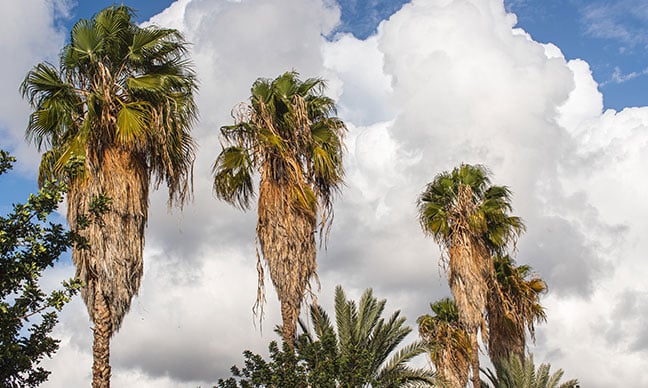From the streets of Los Angeles to the creeks of the Indian Canyons, palm trees are everywhere in California. They are prized possessions in many private landscapes, adding a touch of tropical vibe. Gifted with beautiful weather throughout the year, growing palm trees in California is possible even without being an expert gardener!
If you are curious about how to plant a palm tree and grow one successfully in California, we got you covered. Keep on reading and we’ll share valuable tips!
Related Posts: Palm Tree Care & Palm Tree Trimming
A Step-by-Step Guide on How to Plant a Palm Tree
Ready to take your garden to the next level? Make your landscape more beautiful by adding a nice palm. Below are the most important things you need to know.
1. Pick the Right Variety
One of the most important is to choose the right palm to grow. There are more than 2,600 species available, including those that thrive both indoors and outdoors. Aside from the climate in California, consider the type of soil, space available, and maintenance requirements, among other things.
According to the specialists in tree services California, some of the most popular are Canary Island Date Palm, California Fan Palm, Mexican Fan Palm, and Date Palm. By choosing the right variety, you are significantly increasing the chances of success.
2. Choose the Right Location
Now that you are decided on the variety to plant, the next important consideration of growing palm trees is the location. They vary in light preferences, so you need to consider their needs. Most will thrive in a location with the full sun while others will need shade. The type of soil is also an important factor when picking a location.
Some varieties grow indoors. These are the compact types of palms. However, when we talk about palm trees in California, most of the time, we are talking about those that you can find outdoors. They are similar to those that you will find in palm tree street Los Angeles.
Related Post: Los Angeles Palm Trees
3. Find the Right Time
Timing is crucial to the success of planting a palm tree. Consider the weather, making sure that the plant will thrive based on the conditions of the environment. Palms are tropical plants, and they are most vulnerable in their first winter. So, the best time to plant a palm is from spring to early summer. This will provide the tree up to six months before it experiences its first frost. In most cases, this is enough to establish healthy growth and minimize vulnerability to the cold.
Another importance of timing is that it ensures proper soil conditions. Winter rains are common in California. So, during the colder months, the soil is often too wet, making it attractive for pathogens. This is not an attractive time to introduce a new palm tree in your garden as it is more prone to pests and diseases.
4. Dig a Hole
After choosing the variety to plant and the location, now is the time to get your hands dirty! Position the plant next to the hole so that you have an idea of how big is it that you need to dig. It must be large enough to accommodate the tree. It must be six inches deeper and six inches wider than the existing root ball.
5. Plant the Palm Tree
Once the hole is ready, unwrap the plastic or any material that covers the root ball. Do not shake as this can disturb the existing root structure, making the plant weaker. Position the tree in the hole, making sure that the top part of the root ball is not buried in the soil. Straighten the tree and fill the hole with the soil you have earlier dug.
6. Add Support
In some cases, palm trees are not as straight as they should. They might have a crooked shape, which will make them lean heavily on one side. It is recommended that you add solid support. This will also prevent it from being knocked down when it is windy. This is needed until the tree establishes its root system, allowing it to stand firm on the ground. While you wait for that to happen, see to it that the tree isn’t leaning.
7. Water the Tree
Watering is one of the most important requirements when growing palm trees. Especially during its younger years, it needs regular watering. Water it daily in the first week. Add more water during a drought. Minimize the watering as the plant establishes itself. Over-watering increases vulnerability to diseases, so make sure to watch out how much water is added by the plant.
8. Fertilize as Needed
In most instances, you will not need fertilizers to help the tree grow. However, if you want to speed up its development and increase its rigor, it wouldn’t help to provide the right fertilizer. This will help in the improvement of nutrient delivery. Magnesium, manganese, and iron are important for a good-looking crown. However, do not fertilize until about two months. Otherwise, the plant can experience shock.
9. Trim to Maintain the Crown
Regular pruning is essential for healthy palm trees. Not to mention, this will maintain its compact and attractive shape. It is an eyesore if the fronds are all over the place. Avoid cutting too much and too often. Sanitize the tools before cutting the crown to avoid infection. If you are unsure about how to do this the right way, it is best to hire the services of the experts in tree trimming California.
Proper timing is also important when trimming palm trees. According to experts, it is best if you do it in spring. Do not prune when it is too hot or too cold as the extreme weather increases the vulnerability of the plant.
10. Watch Out for Pests and Diseases
Growing palm trees also require awareness of the pests and diseases that can harm their health. Some of the most common pests include cabbage palm caterpillar, palm budworm, giant palm borer, royal palm bug, and South American palm weevil. Meanwhile, some of the most common diseases are leaf spots, false smut, and sudden crown drop.
The best way to avoid the most common palm tree diseases is to increase the vigor of the plant. From regular fertilizing to watering as needed, pay attention to its needs. Also, dispose of diseased branches to avoid the infection from spreading.
Related Posts: How To Revive A Dying Palm Tree & How To Get Rid Of Palm Rats
FAQs
Q: Can I plant a palm tree in my yard?
A: Yes, you can plant a palm tree in your yard! You can even start planting in pots and transplant once the tree is large enough. All that you need is to choose a good location. For instance, you will need full sun and well-draining soil. If these conditions are present in your yard, then you can grow a palm tree!
Q: What type of soil is best for palm trees?
A: The best soil for palm trees is loose and porous. It should be well-aerated, so adding shredded bark and peat moss will help, especially if you will plant the palm tree in a pot. The soil should also be well-draining.
Q: How long do palm trees take to grow?
A: The rate of a palm tree’s growth depends on several factors, such as the variety and environmental conditions. On average, it grows one to three feet in a year and will reach its full height in 20 years. Some species can grow up to 100 feet, such as the Mexican fan palm, which is also one of the most common palm trees in San Diego.
Q: How often should you water a newly planted palm tree?
A: Palms trees are moisture-loving plants, so you will need to water new plants daily in its first week. On the second week, water every other day. After this, water only once to thrice a week or as needed.
Q: Can palm trees stay in pots?
A: Yes, palm trees can stay in pots, but you have to choose the right varieties. Pick those that are slow-growing or low-growing. These varieties can stay in the pot for two to three years. As they grow bigger, you have to transplant in a roomier location. Some will not grow too big, and hence, you can keep them in a pot without any problem.
Q: Are palm trees easy to grow?
A: Yes, palm trees are easy to grow! The size can be intimidating, but with a bit of patience and little knowledge, they are easy to grow! Choose low-maintenance varieties that thrive well in California, such as King Palm, European Fan Palm, and Date Palm, among others.
Local Tree Experts Overview
At this point, we hope that you have learned a thing or two about how to plant a palm tree in California. The most important is to pick the right variety, specifically one that is suited for the Mediterranean-like climate of the state. Choose the right location in your yard and make sure that it has a suitable sun and soil requirements. As the plant grows, pay attention to watering, fertilizing, and pruning, among other essentials for tree care and maintenance.




